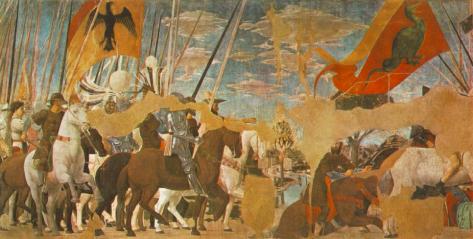Art critics have debated and written at great lenght about the History of the True Cross, the sequence of frescoes by Piero della Francesca (1416-1492), painted between 1452 and1466, in the Basilica of San Francesco inArezzo. But indeed it’s mostly thanks to the art historian Daniel Arasse, if we highlighted the consciously archaic choices are one of the main ideas behind this artist.
At the same time, critics, repeatedly, pointed out the similarities that bound the two battles of the History to the (older) “triptych” of the Battle of San Romano (1438-1460) by Paolo Uccello.
Similar are the suspended atmosphere, the frozen attitude as in heraldic poses, the inexpressive faces, the use of a “sui generis” space.
The violence of the fight is revealed by the splendid, artful saturation of the space obtained by multiplying the number of the spears and the horses’ legs, as well by varying the shapes of helmets and hats and, finally, by adopting an anti-naturalistic scene. It’s enough to observe in the ‘Battle of Milvian Bridge’, the strange sinking of a horse in a river that suddenly ends, right in the middle of the scene. Piero della Francesca, an expert in perspective, as shown in his treatise De prospectiva pingendi, he could have chosen many other different solutions instead, but he hadn’t.
As explained by Arasse: “The (temporary) Piero’s archaism is based on the essential quality of his art, radically opposite to several basic principles of XV century Renaissance humanistic painting – called “modern” at that time – as formulated in 1435 by Leon Battista Alberti in his De Pictura: a clear explanation of the story (the plot), as the representation of movements and expression by the emotions of the characters. ”
As we were saying: this style, compared to the humanistic conception of painting, was so “antiquated” that soon it would have gone out of fashion, outclassed by anatomical and physiognomic researches by Leonardo and Michelangelo, and also by the “abstruse constructions” by Bella Maniera (Mannerism).
So “obsolete” that, within few decades from the realization, others did not hesitate to destroy his frescoes in the Castle Estense (1449), in Ferrara, nor those (1458-59) in the Stanze in the Apostolic Palace (Palace of the Vatican) to “modernize” the halls as, in fact, stated by Vasari.
—————————————————————————————————
PIERO DELLA FRANCESCA, L’ARCAISMO NE LE STORIE DELLA VERA CROCE.
Sul ciclo di affreschi della Basilica di San Francesco, ad Arezzo, le Storie della Vera Croce dipinte da Piero della Francesca (1416-1492) tra il 1452 e il 1466, si è detto e scritto moltissimo, ma è merito soprattutto dello storico dell’arte Daniel Arasse l’aver evidenziato le scelte consapevolmente arcaicizzanti alla base di questo artista.
Similmente, inoltre, sono state più volte evidenziate le affinità che legano le due battaglie della Storie al (più antico) “trittico” della Battaglia di San Romano (1438-1460) di Paolo Uccello.
Medesima è l’atmosfera sospesa, la concitazione raggelata in pose araldiche, l’inespressività dei volti, il ricorso ad una spazialità “sui generis”.
La violenza della mischia è rivelata dallo splendido artificio della saturazione dello spazio ottenuta moltiplicando a dismisura il numero delle lance e delle zampe dei cavalli, nonché variando le forme di elmi e cappelli, e infine adottando trovate antinaturalistiche.
Basti osservare, nella Battaglia di Ponte Milvio, l’incongruo sprofondare del cavallo in un fiume che s’interrompe, all’improvviso, al centro della scena.
Piero, esperto conoscitore della prospettiva, tanto da scrivere un trattato (De prospectiva pingendi), avrebbe potuto scegliere mille altre diverse impostazioni, e invece no.
Come dice Arasse: “L’arcaismo (temporaneo) di Piero si fonda su qualità essenziali della sua arte che si oppongono radicalmente ad alcuni principi basilari della pittura umanista – ossia “moderna” – del Quattrocento, quali li aveva formulati nel 1435 Leon Battista Alberti nel suo De pictura: chiarezza narrativa dell’istoria, rappresentazione del movimento ed espressione delle emozioni delle figure”.
Talmente “antiquato” rispetto alla concezione umanista della pittura che, ben presto, il suo stile sarebbe “passato di moda”, surclassato anche dalle ricerche anatomiche e fisiognomiche di Leonardo e Michelangelo, nonché dalle “costruzioni astruse” della Bella Maniera.
Talmente “obsoleto” che, a pochi decenni dalla realizzazione, non si sarebbe esitato a distruggerne gli affreschi del Castello Estense (eseguiti nel 1449), a Ferrara, nonché quelli delle Stanze Vaticane (1458-59) per “modernizzare” le sale, come, appunto, precisò Vasari.
